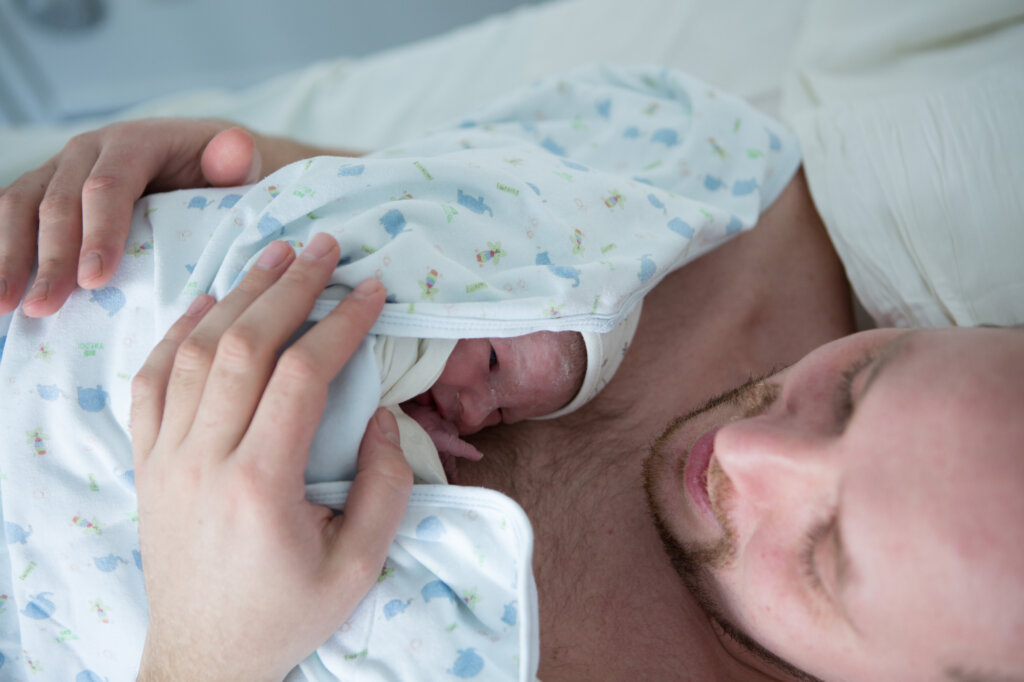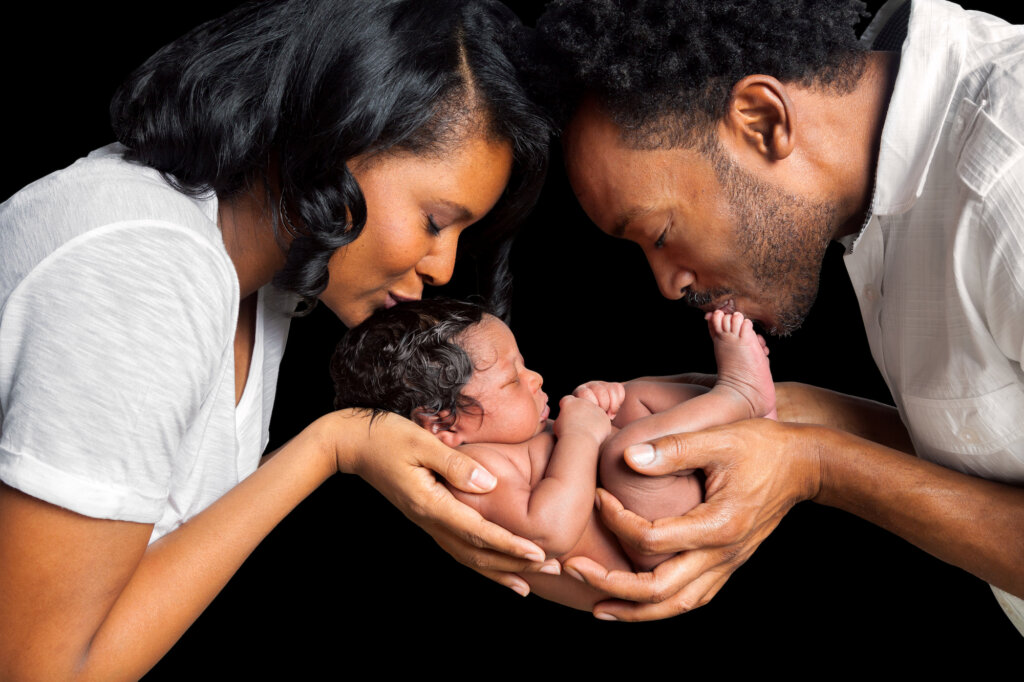How to Prevent Paternal Perinatal Depression


Written and verified by the psychologist Gorka Jiménez Pajares
Depression is a clinical disorder that can arise at specific times such as pregnancy and childbirth. In this instance, it gives rise to perinatal depression. It can affect both the mother and father. In fact, although the condition is often associated with women, there are increasing numbers of fathers experiencing the symptoms of perinatal depression.
There are various reasons for the increase in diagnoses among fathers. Among them is greater awareness and, thus, better identification of perinatal depression by professionals. Furthermore, changes in gender roles and an increase in paternal involvement mean that fathers are frequently more involved in the care of their children (along with the pressure this often entails).
It’s crucial that we understand the importance of preventing perinatal depression. Sadly, in the most severe of cases, it can result in suicide. There’s also a tendency for it to cause a significant deterioration in the relationship between the father and the child. Next, we’ll give some guidelines for increasing awareness of this problem and dealing with it.
“Depression is the inability to construct a future.”
-Rollo May-
Paternal perinatal depression
The word delivery can make the heads of both mothers and fathers spin. This isn’t only because of the sensitivity of the event itself, but because having a child requires important psychosocial change. In fact, the birth of a child impacts spheres as diverse as work, family, and interpersonal relationships.
However, thanks to the greater awareness we mentioned earlier, today, there are many studies available on the subject. For example, a review published in The Lancet Global Health sheds light on the factors related to perinatal depression. As a matter of fact, this research found a link between paternal and maternal perinatal depression (Chmielewska et al., 2021).
This means that both partners often develop symptoms of depression or a fully developed clinical disorder.
Unsurprisingly, its consequences on the dad-mom-baby family system are quite negative. So much so that research suggests that parental depression inhibits the normal development of infants’ social skills (Sweeney et al., 2016). Moreover, it constitutes a springboard to various forms of abuse and neglect (Takehara et al., 2017).
“The opposite of depression is not happiness but vitality…”
-Andrew Solomon-
The prevention of paternal perinatal depression
Many investigations have been conducted on the subject of identifying fathers who present a high risk of developing perinatal depression (Iwata et al., 2023). In fact, researchers have reported the following risk factors(Ansari et al., 2021):
- Stress.
- Depression in one of the partners.
- Little satisfaction in the relationship.
- Perception of little social support.
- Infertility treatments.
- History of mental health problems.
- A lack of economic stability.
To minimize the danger, different interventions have been developed. The protocols focus on three areas: the father and mother individually, the couple, and the family (Birken et al., 2023).
“Depression is a world, depression leaves you lost, depression drops you into a never ending black hole, you want to get help but you can’t …”
-Aaron T. Beck-

1. Father-focused intervention
This therapy focuses exclusively on the father. The following elements are addressed during the sessions (Birken et al., 2023):
- Guidelines on style or daily routines. For instance, the therapist might teach habits related to sleep hygiene or the treatment of sexual dysfunctions, if necessary.
- Skin-to-skin contact. This is extraordinarily powerful. Indeed, if a father holds their baby for at least half an hour, in contact with his chest, devoid of any clothing, it can protect against paternal perinatal depression.
- Teaching practical skills. For example, the therapist might suggest the father give their partner a massage. This relieves the pain they’re experiencing as a result of the physiological changes that occurred during childbirth. Moreover, it reinforces their relationship and the biological connection with the process that they’re both going through.
The core of therapeutic intervention is mainly educational. It seeks to provide the father with strategies to enhance the emotional bond with both the mother and their newborn.
“The heart of conscious parenting is the ability to be present in any situation that arises.”
-Shefali Tsabary-
2. Interventions focused on the couple
The base of therapy in this respect is the husband-wife dyad. Its aim is to prevent depression and promote the quality of the bond that unites them. The sessions cover issues such as both partners being parents ‘together’ and how they must ask for help if they find themselves in trouble.
The therapy also addresses the challenges of parenthood. It recognizes that the husband-wife relationship may have undergone certain changes. For example, they have less time to spend with each other. Consequently, the implications of the transition from the “husband-wife dyad” to the “dad-mom-baby” triad are discussed.
“Be deliberate with your behaviors, words and responses, both as a parent and a business leader, because people are watching and learning.”
-John C. Maxwell-
3. Family-focused interventions
These interventions often include sessions with parents in similar situations. According to Birken et al., 2023, some of their components are as follows:
- Education for parents whose children were born prematurely.
- Psychoeducational mobile apps focused on new parents.
- Behavioral training for parents of newborns in neonatal intensive care.
For mothers, an example of online intervention is found in the MomMoodBooster program (Fonseca-Pedrero et al., 2021). This scheme is based on cognitive behavioral therapy. It seeks to resolve various symptoms. For example, pessimism, insufficient self-esteem, or social isolation.

Promising strategies for treating paternal perinatal depression
As you can see, increasingly more cases of paternal perinatal depression are being diagnosed. Furthermore, this disorder is often linked to maternal perinatal depression.
For this reason, interventions are aimed at addressing the father-husband-wife relationship and the mother-dad-baby triad. Their results are promising. That said, further research is required.
“Once a depressed person becomes active and hopeful, self-esteem always improves.”
-Martin Seligman-
All cited sources were thoroughly reviewed by our team to ensure their quality, reliability, currency, and validity. The bibliography of this article was considered reliable and of academic or scientific accuracy.
- Ansari, N.S., Shah, J., Dennis, C.L., et al. (2021). Risk factors for postpartum depressive symptoms among fathers: a systematic review and meta-analysis. Acta Obstetricia et Gynecologica Scandinavica, 100(7), 1186–99. https://obgyn.onlinelibrary.wiley.com/doi/full/10.1111/aogs.14109
- Birken, M., Chipp, B., Shah, P., Olive, R.R., Nyikavaranda, P., Hardy, J., Chhapia, A., Barber, N., Lee. S., Pearce, E., Lloyd-Evans, B., Perkins, R., McDaid, D., Stefanidou, T., Shafran, R., Pitman, A., Johnson, S. (2023). Exploring the experiences of loneliness in adults with mental health problems: A participatory qualitative interview study. Plos One, 18(3). https://journals.plos.org/plosone/article?id=10.1371/journal.pone.0280946
-
Chmielewska, B., Barratt, I., Townsend, R., Kalafat, E., van der Meulen, J., Gurol-Urganci, I. & Khalil, A. (2021). Effects of the COVID-19 pandemic on maternal and perinatal outcomes: a systematic review and meta-analysis. The Lancet Global Health, 9(6), e759-e772. https://www.sciencedirect.com/science/article/pii/S2214109X21000796
-
Iwata, H., Mori, E., Maehara, K., et al. Preventive interventions for paternal perinatal depression: a scoping review protocol. (2023). BMJ Open, 13:e065126. https://bmjopen.bmj.com/content/13/3/e065126
- Fonseca Pedrero, E. (2021c). Manual de tratamientos psicológicos: Adultos (Psicología) (1.a ed.). Ediciones Pirámide. https://es.slideshare.net/SilviaValdiviaVasco1/519256960manualdetratamientospsicologicosadultosbyeduardofonsecapedreropdf
- Sweeney, S., MacBeth, A. The effects of paternal depression on child and adolescent outcomes: a systematic review. Journal of affective disorders, 205, 44–59. https://doi.org/10.1016/j.jad.2016.05.073
- Takehara, K., Suto, M., Kakee, N., Tachibana, Y., & Mori, R. (2017). Prenatal and early postnatal depression and child maltreatment among Japanese fathers. Child abuse & neglect, 70, 231–239. https://doi.org/10.1016/j.chiabu.2017.06.011
This text is provided for informational purposes only and does not replace consultation with a professional. If in doubt, consult your specialist.








